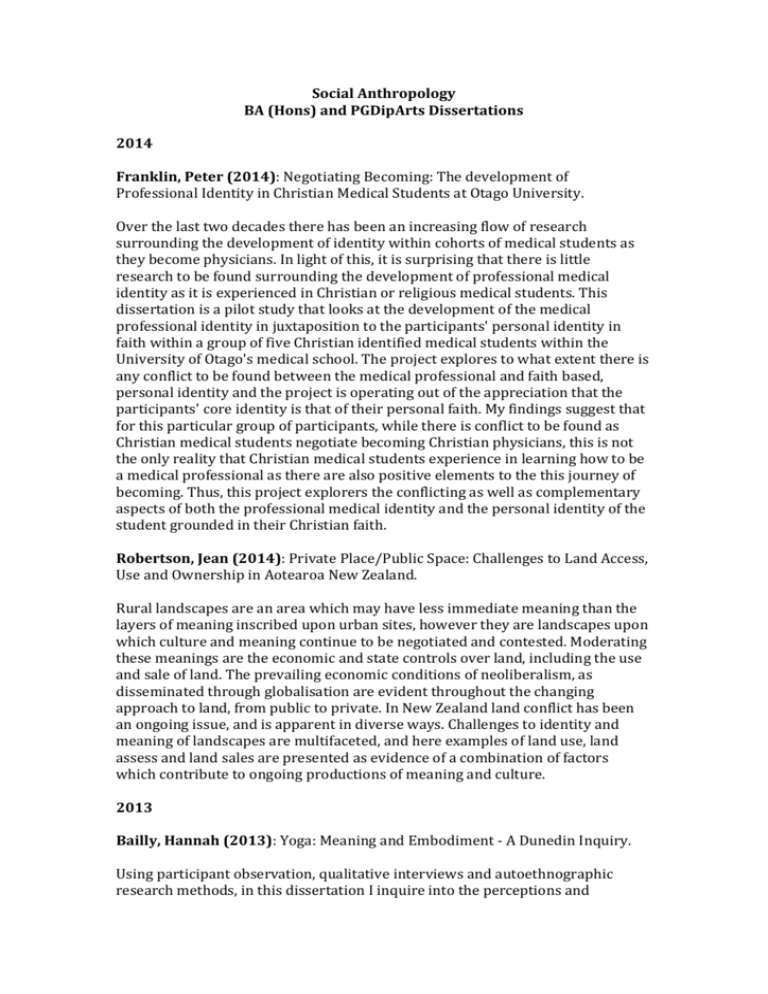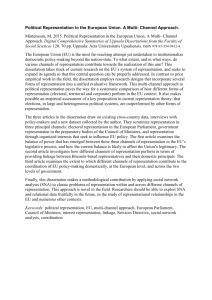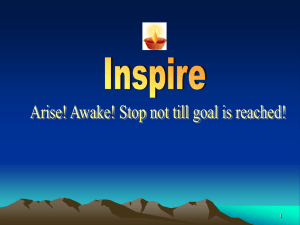Social Anthropology - University of Otago
advertisement

Social Anthropology
BA (Hons) and PGDipArts Dissertations
2014
Franklin, Peter (2014): Negotiating Becoming: The development of
Professional Identity in Christian Medical Students at Otago University.
Over the last two decades there has been an increasing flow of research
surrounding the development of identity within cohorts of medical students as
they become physicians. In light of this, it is surprising that there is little
research to be found surrounding the development of professional medical
identity as it is experienced in Christian or religious medical students. This
dissertation is a pilot study that looks at the development of the medical
professional identity in juxtaposition to the participants' personal identity in
faith within a group of five Christian identified medical students within the
University of Otago's medical school. The project explores to what extent there is
any conflict to be found between the medical professional and faith based,
personal identity and the project is operating out of the appreciation that the
participants' core identity is that of their personal faith. My findings suggest that
for this particular group of participants, while there is conflict to be found as
Christian medical students negotiate becoming Christian physicians, this is not
the only reality that Christian medical students experience in learning how to be
a medical professional as there are also positive elements to the this journey of
becoming. Thus, this project explorers the conflicting as well as complementary
aspects of both the professional medical identity and the personal identity of the
student grounded in their Christian faith.
Robertson, Jean (2014): Private Place/Public Space: Challenges to Land Access,
Use and Ownership in Aotearoa New Zealand.
Rural landscapes are an area which may have less immediate meaning than the
layers of meaning inscribed upon urban sites, however they are landscapes upon
which culture and meaning continue to be negotiated and contested. Moderating
these meanings are the economic and state controls over land, including the use
and sale of land. The prevailing economic conditions of neoliberalism, as
disseminated through globalisation are evident throughout the changing
approach to land, from public to private. In New Zealand land conflict has been
an ongoing issue, and is apparent in diverse ways. Challenges to identity and
meaning of landscapes are multifaceted, and here examples of land use, land
assess and land sales are presented as evidence of a combination of factors
which contribute to ongoing productions of meaning and culture.
2013
Bailly, Hannah (2013): Yoga: Meaning and Embodiment - A Dunedin Inquiry.
Using participant observation, qualitative interviews and autoethnographic
research methods, in this dissertation I inquire into the perceptions and
experience of seven contemporary yoga practitioners, as well as my own, to
explore the embodied meaning of yoga in the Dunedin context. Suggesting that
yoga's surge of popularity in the West may have more to do with aspirations for
health and body maintenance than the spiritual aspirations of classical yoga's
original design, I ask whether engaging with the age old postures and techniques
of hatha yoga might bring about unanticipated and sometimes transformational
outcomes for its practitioners. To explore the evidently vast appeal of yoga to its
Western—and more specifically, Dunedin—practitioners, I invoke Foucault's
(1983) sociopolitical theories of embodiment, and address how the subjective
self is constituted through alignment with dominant ideologies of health and
fitness. To explore whether an embodied practice of hatha yoga might subvert
ideologies which reinforce an obsession with body-image, I invoke
phenomenological theories of embodiment and practice—especially the insights
of Marcel Mauss ([1935]1973) and Pierre Bourdieu (1990) who elucidate how
culturally shared techniques of the body are stored as bodily memory and
accessed through schemas of movement. I am interested in whether the
enactment of asana (yogic posture) and pranayama (yogic breathing)
predisposes the practitioner to (latent) spiritual qualities embedded in yoga's
original design.
Gilmore, Des (2013): A Marriage for Three: Five Young Adults Experiences of
Christian Dating in Dunedin, New Zealand.
This dissertation looks at five young adult Christians and their experiences with
dating in in Dunedin, New Zealand. Though dating itself may be the focus of a
number of academic studies, Christian specific research is less common. In this
dissertation I examine the ways in which young Christians negotiate dating
relationships while maintaining a personal relationship with Jesus. I frequently
refer to Elizabeth Shively’s (2012) thesis based with home-schooled young adult
Christians in the United States as a point of comparison with my own research,
particularly in regards to her concepts “Luminous Femininity” and “Radiant
Modesty.” Taking a qualitative approach to this research, I gathered my data
from one-on-one unstructured interviews with each participant. Topics included
“hurts and scars” ” (emotional baggage created by a divergent sexual past), God’s
presence in the dating relationship and rational preparations for dating and
marriage. I suggest that a combination of these factors lead to variable values in
perceived marriage futures from each participant, and that such marriage
futures are a specific way of managing the potential pitfalls that could arise in
dating relationships.
Robins, Erena Inara (2013): Action In Time: Reflections on the Transition
Initiative.
This dissertation explores and seeks to understand the construction of time
within the Transition initiative. It investigates anthropological notions of time,
the relationship between time and environmental factors, and the effect that
models of time have on the way that humans think, act and feel. I argue that the
most significant model of time in Transition is not the model that characterises
the most prevalent discourses surrounding environmental issues such as peak
oil and climate change, which purports the notion that ‘time is running out’ and
often that it is ‘too late’ to do anything. The construction of time in the Transition
initiative is complex, subsuming this environmental narrative. It describes a time
that can be moulded and shaped by human actions, one in which the demise of
the planet as we know it is not the only possible outcome. In this ‘agentive’
model the purpose of action is to create the future that the people of Transition
would like to see. I explore the treatment of time in Transition on a macro scale,
and also a micro scale in relation to case studies of Transition Town Totnes (the
most established Transition initiative), and the local example of Transition Town
Waitati. Finally, I conclude that the purpose of the agentive model in Transition
is in essence the creation of meaning in the lives of its participants.
Scarth, Bonnie (2013): Print Media Reporting of Suicide in New Zealand: Do We
Really Need to 'Open Up'?
Since 2010 the chief coroner Judge Neil MacLean has being calling for an
‘opening up’ of suicide reporting in mainstream New Zealand (NZ) media.
MacLean believes this will assist in suicide prevention measures by allowing the
public to learn from the stories of families who have lost a loved one to suicide.
MacLean also argues that the mainstream media can assist in regulating
knowledge shared about suicide on social media. By analysing fifty six
mainstream print media articles from January 2010 to April 2013, I argue that
MacLean’s reasoning for ‘opening up’ a ‘conversation’ on suicide through the
mainstream media is questionable when situated within the primary themes that
emerged from my data and evidence from my literature review. The primary
themes that emerged are making meaning, medicalisation, and youth and social
media, and these problematize the chief coroner’s position on liberalizing
mainstream media reporting of suicide in NZ. This analysis is contextualised with
a critical review of the death taboo implicitly (and explicitly) utilized in media
representations pertaining to suicide. I conclude that MacLean’s argument for
‘opening up’ suicide reporting is simplistic and at odds with his reported desire
to regulate social media. Further research possibilities exist in the articulation of
an appropriate and safe means for ‘open’ conversations on suicide.
2012
Broad, R. H. (2012): Conversations about post lingual deafness, disability and
cochlear implants; A South Island family Study
This study draws on interviews, observations and fieldwork with three family
membersof a larger South Island extended family kinship network who can
count at least five members of their family who are deaf/ hard of hearing, plus
many more in their extended family. The project was designed to explore the
meaning of disability for members of this family in relation to the topic of
deafness with an openness to the possibility that family members would not
consider deafness to be a disability at all. Another topic which was investigated
was the experience of hearing with a cochlear implant device as all participants
in this project had been fitted with such a device by the Southern Cochlear
Implant Programme {SCIP). The interview analysis revealed that the family did
not consider themselves as disabled or that their type of deafness was a
disability, although they were able to identify moments when they had difficulty
hearing, particularly in noisy situations or when multiple people are talking at
once. The participants were also asked to comment on whether their experience
of deafness had any impact on their thoughts about future children, they were
also asked to consider the social impact of genetic testing for conditions such as
deafness. An additional feature of this study was the conduction of an informal
interview via email and telephone with a member of SCIP which oversees fitting
of cochlear implant devices as well as post-operative patient care and
rehabilitation. The purpose of this component of the study was to discuss the
manner in which SCIP presents information about cochlear implants given the
larger debates in the D/deaf communities about the ethical use of such hearing
devices. This larger debate along with discussions on the nature of deafness as a
disability is reviewed in the literature review. The overall finding of this project
was that when considering whether or not being deaf is an experience of
disability it is very important to understand the social context in which deafness
occurs. In this family all the family members had post lingual deafness in which
their hearing 'dropped ' many years after they had acquired spoken language
skills. It is the capacity to have acquired a language- spoken English -before their
deafness occurred and the fact that the participants have a large family of deaf
people that makes their experience different in several ways to people who
experience other forms of deafness, such as those who have profound deafness
from birth. This also makes their understanding of cochlear implants quite
different to people who are profoundly deaf at birth. ) predisposes the
practitioner to (latent) spiritual qualities embedded in yoga's original design.
Murphy, Bell Alicia (2012): Anthropology, Climate Justice and Grassroots
Initiatives for Change
This dissertation explores the ways in which anthropologists can support
grassroots initiatives for climate justice. As such, it is a rudimentary survey of
how fields of power intersect with ecological landscapes; how people within
these landscapes are working toward social and environmental change from
below; and how anthropology fits into this picture. The 'solutions' being
proposed by states and big business are not only failing to reduce emissions,
they also fail to address the global power relations, which lie at the root of
climate change and environmental injustice. I argue that grassroots initiatives
provide fertile ground for empowering, resilient and sustainable processes for
social and environmental change in ways that 'top-down' approaches do not.
They also face many challenges internally which are crucial sites of struggle for
genuine and lasting change. I consider these issues in relation to case studies
from the Siberian Arctic, the Pacific, India and the Gulf of Mexico. I also explore
the social and political praxis of the radical climate justice movement and in
particular the international Camp for Climate Action initiative. Informed by
anarchist principles, radical climate justice activism is a heterotopia which faces
many challenges. These challenges frustrate the realisation of certain goals but
also provide opportunities for dialogue and self-reflexivity which, in turn, can
build stronger alliances and influence the movement. I conclude that careful,
robust and reflexive ethnography, could bring valuable insights to assist in
negotiating the cultural and social opportunities, possibilities and challenges
people face in attempting to organising from the bottom-up for climate justice.
Pyarambon, Jessica Lesley (2012): The Voices of Papua New Guinea Nurses in
the Educational and Professional Journey
The socio-cultural and economic environment in Papua New Guinea (PNG)
places some members of the society in a more disadvantaged position than
others in spite of the country's constitutional policy of equal opportunity for
every individual. The aim of this research was to allow female voices (nurses) to
share their own experiences of gender inequality and disparity in the
professional and educational field. This auto-ethnographic method of research
allowed the researcher to embody the self as the key protagonist in the research.
The author's cultural experience and voice was complemented by three
participants and the secondary literature. In order to avoid the common pitfalls
in auto-ethnography, the auto-ethnographer invited external voices through
semi-structured open-ended interviews. The key results of the research revealed
that parents' tradition and educational opportunity, overcoming gender barriers,
personal belief and family and mentoring helped the women in their pursuit of
education and professional advancement. Despite the gender and cultural
barriers, these voices have successfully overcome the obstacles through
enhancement in career development and have secured elite positions within
their speciality to improve and enjoy life with their families.
Robinson, Ella (2012): Lived, Embodied, Danced: Doing Spirituality
In the manner of auto-ethnography, this dissertation is a first-person exploration
of the themes of spirituality, dance, and the anthropology of embodiment; more
specifically, the embodiment of spirituality. It is also a story of the embodied
anthropology student, navigating her way through the research and writing
process. Knitting together memories of conversations with four women dancers
in Dunedin, New Zealand, along with dancing memoirs, relevant diary entries
and anthropological and dance research literature, I answer the following
questions: How do I make sense of my growing interest in spirituality when I had
no background focus on this aspect of personhood during my childhood? Why do
I sense that this spiritual interest is related to my dance practice? Are there
others who share this sensibility? This venture into my recent and distant past
reveals the importance of practice and the immediate, multisensory knowledge
of the lived body when it comes to understanding dancing, spiritual knowledge.
Saunderson-Warner, Harry (2012): Online Embodiment: Facebook and the
Creation of Hyper-Self
Facebook is an online social network consisting of over 1 billion users
worldwide, who create profiles and share their own and others material. While
the website operates in the virtual world of the internet, the spaces and practices
it creates and utilises, resonate with social theories such as Lefebvre's
production of Space and Foucault's analysis of Bentham's Panopticon. Through
analyzing Facebook in relation to these approaches, it becomes apparent that
Facebook is a social space, in which the audience plays a vital role in providing
context and meaning for the image which the user is portraying. In generating
this image, members must navigate concerns such as privacy, real world
consequences of online action and how to give meaning to the virtual world. The
image that members portray is that of a hyper-self, an image which is manicured
to negotiate the audience as well as online and offline consequences.
2010
Begley, Juliet (2010): The Politics of Concealment: The Manifestations of Race
in the Northern Territory Emergency Response Intervention
On 21 June 2007, Australian Prime Minister John Howard declared a “national
state of emergency” in Aboriginal communities in the Northern Territory
(Howard 2007). The Howard Government implemented a series of draconian
and invasive measures in 73 prescribed Indigenous townships and remote
communities with little or no consultation with Aboriginal people. This
dissertation focuses on five political addresses made by Prime Minister John
Howard and Minister of Families, Housing, Community Services and Indigenous
Affairs Mal Brough. These speeches are saturated with racial descriptions,
connotations and stereotypical assumptions of Aboriginality. These speeches
emphasise child sexual abuse in ways that concentrate criminal offending in
Aboriginal communities, ignoring the fact that this is a problem across Australia.
This was used to justify the intervention, taking control of Aboriginal lives in a
manner that reflects the continued legacy of racism in Australian politics. The
intervention invoked representations of Aboriginal people as being ‘disordered’
and ‘inferior’ that also characterised colonial racist policies and interventions in
the past. The concept of race, with its origins in biological difference continues to
inform stereotypes, conceptions and constructs of Australian ‘cultural
difference’. This is manifested in Australian politics through the rhetoric of
normative racism, hidden racism, and anti-racism. This dissertation explores
how the concept of race, and the various ways it manifests in politics, was a
distinguishing feature of the 2007 Northern Territory Emergency Response
intervention.
2009
Carrington, Michela (2009): Becoming a Doctor: An Embodied
Autoethnography of Emerging Clinical Practice.
Many existing epistemologies which influence the production, distribution and
consumption of commodities on a global scale are currently being questioned
and reviewed. This is due to increasing debates and concerns about the future
survival of earth and our inhabitance on it. Issues such as global warming,
environmental degradation and natural resource over-extraction are generating
much attention, which pockets of environmentalist movements globally are
mobilising in response to. Among these groups is a community oriented
organisation called WEGgies, located in a New Zealand South Island town called
Waitati. It is this group which I conduct my research on through engaging in
qualitative participant observation. While investigating WEGgies I learned their
actions were embedded in a narrative that embraced the crisis theory as
demonstrated above. They formed as a grassroots movement in opposition to
central government’s inadvertence to sufficiently address a possible future
environmental and social disaster. Through their grassroots activism WEGgies
rallied to forge and solidify a local food network which they foresaw as creating a
degree of community resilience against potential structural, social and
environmental collapse. This has constructed a model of community
sustainability specific to the geographical location and cultural makeup of
WEGgies. These actions represent a shift in food production and distribution
regimes and environmental and social relations which reflect what Andre
Edwards calls; the Sustainability Revolution. It is this assumption which I have
investigated WEGgies actions in accordance with.
Cowie, Rachael Anne (2009): Viewing Sustainable Waitati through the Lens of
Edible Gardens.
In New Zealand, many of the embodied skills of medicine are learnt by medical
students within real clinical contexts in a public and often high stakes
environment. During clinical training, medical students are gaining these skills
for the first time and are hyper-alert to the active work involved in their
acquisition. However, little research examining the embodied nature of this type
of learning has been conducted. This study reflects on the embodied work
involved in becoming a doctor through analysis of the journaling of my learning
experiences while a fourth year (first year clinical) medical student on both
general practice (primary care) and surgical ward rotations. I use an autoethnographic approach to construct my embodied learning experiences as both
the subject (myself as medical student) and the researcher (myself as
anthropologist). Looking at my experiences though the lens of embodiment, I
reflect upon learning ‘doctoring’ using my own experiences as a case study.
Harwood, Erin (2009): The Dog Squad: An exploration of Volunteer
Experiences in Dunedin.
The Dog Squad: An exploration of volunteer experiences in Dunedin, aims to
provide a qualitative investigation of the experiences and motivations of the
individuals that volunteer for the Dunedin based SPCA Dog Squad. This project
was initiated due to the considerable lack of qualitative studies on volunteers
and handlers that are involved in the growing practice of animal-assisted
activities and therapy. Historical perspectives on animal-human relations, the
relatively recent practice of using animals for therapeutic purposes to increase
human health and wellbeing and volunteer theory is discussed to highlight the
experiences and encounters of the Dog Squad volunteers. The present study
provides a description of what the Dog Squad is and what it aims to do. The
volunteers’ backgrounds are explored illustrating that a significant proportion of
the participants held a high degree of human capital. The majority of participants
understood attributes such as having “common sense,” being “easy to talk to”
and having a “bright” personality as being prerequisites for a good volunteer for
the Dog Squad. The present research notes that the majority of Dog Squad
members were motivated to be involved with the group due to self-fulfilling
benefits and social networks, which resonated with the social network and
exchange theories. The present research also observed that the dogs of the Dog
Squad acted as social lubricants, which increased interaction between the
participants and the patients. The participants often engaged in emotional
management to create the appropriate “level” of emotions for the Dog Squad
visits. The present study illustrates that the SPCA Dog Squad is an example of
animal-assisted activity programme, whereby the participants reported similar
perceived benefits to other comparable programmes, including providing a
“break” and a distraction in the day, reduced or diverted pain perception and
increased social interaction.
Stallard, Kirsten (2009): RSE Participants in the Print Media of Marlborough
2008.
This dissertation investigates the representation of the Pacific Island Recognised
Seasonal Employer (RSE) scheme participants in the print media of Marlborough
during 2008. The results for this study are based on the analysis of 108 articles
gathered from between January 1st 2008 and December 31st 2008 from four
local newspapers in Marlborough. This project argues that the Pacific Island RSE
participants are represented as an objectified labour resource, which is largely
excluded from the community. This is based on a discussion of the concept of
‘community’ and how individuals may be considered ‘insiders’ and or ‘outsiders’
based on the use of shared common symbols. These notions of ‘community’,
demarcating ‘insider’ from ‘outsider’ and ‘self’ from ‘other’, are evident in the
representations of RSE participants in the Marlborough region. This draws from
the culturally mediated politics of representation of earlier media portrayals of
the New Zealand dawn raids in the late 1970’s and also, somewhat disturbingly
from the indentured labour system between Australia and the Pacific in the late
19th century.








